The striped bass has a strong case for being the official bass of the Northeast. These hard-fighting fish captivate anglers throughout the region anytime they are around, and there are many ways to catch them, from surf casting on the beach to jigging or trolling both inshore and offshore. During the summer, some of the best Northeast striper fishing happens on the boats of Captain Brian Coombs of Massachusetts’ Get Tight Sport Fishing and Captain Robert Taylor of Rhode Island’s Newport Sport Fishing Charters.
While the two know each other and are separated by less than 75 miles of land, they have vastly different fisheries and vary their approach to target monster striped bass during summer. Capt. Taylor most often fishes offshore, and Capt. Coombs is able to fish both inshore and offshore with the same results.
INSHORE VERSUS OFFSHORE STRIPED BASS
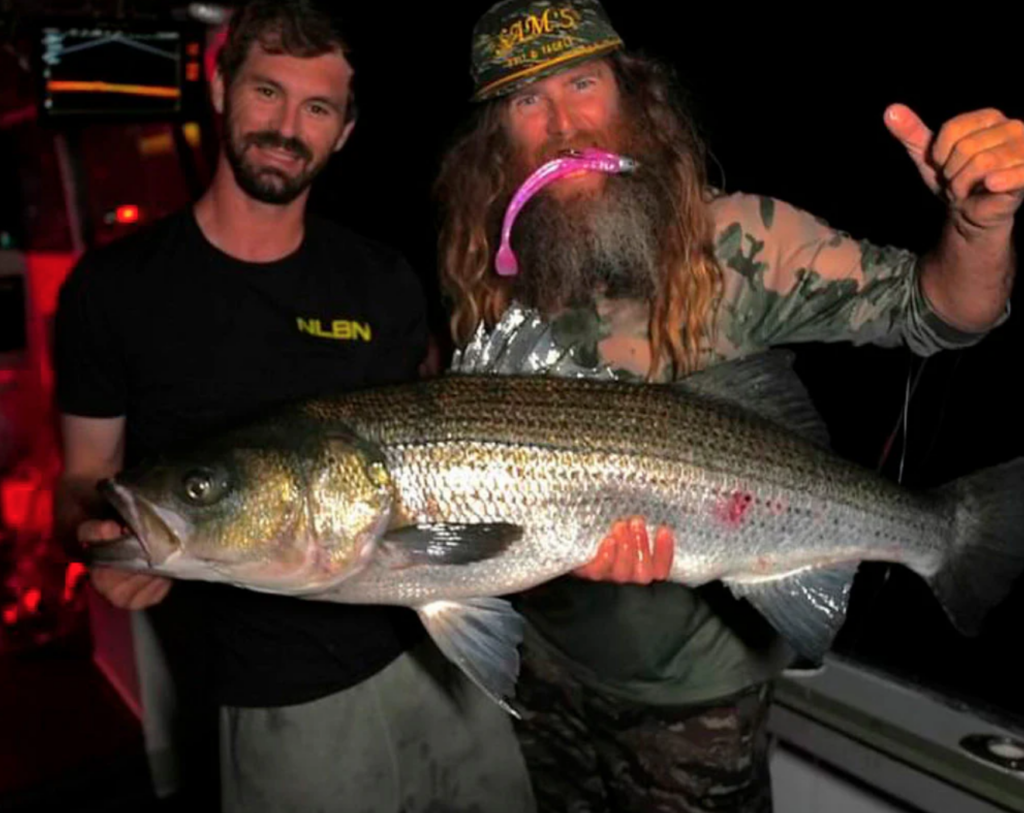
Between the two popular Captains is Cape Cod, which serves as a barrier and affects the striped bass and their behavior, according to Capt. Taylor. This also changes where they primarily fish.
“The southern water below the Cape has water temperatures almost 10 degrees warmer than above it,” Taylor said. “When the fish funnel out of the shallows here, they get much deeper quickly. They still come in at night and you can catch them surf fishing, but most of my fishing is done in deeper water.”
When fishing offshore, Taylor and his clients fish soft plastic swimbaits on jigheads or live eels. Summer is prime time for his clients to catch 30- to 50-pound stripers in the 40- to 50-inch class.
“The fishing starts to get good around Mother’s Day for big fish and runs until the end of August when we switch to tuna,” he said. “We generally fish anywhere from 30 to 65 feet deep and fish a lot of structure for the striped bass. A lot of it is tide driven. We sweep the baits over reefs by drifting or putting our boat on Spot-Lock and letting the current work our baits.”
As a native Bostonian, Capt. Coombs offers his clients a unique striped bass fishing experience as summer progresses. He fishes amongst skyscrapers from his home base in Boston Harbor, located in downtown Boston.
“We fish under the skyline, and I can give them a little tour of the city; it’s as urban as you can get,” shared Coombs. “This time of year we target the pelagic fish out deep, chasing sea herring offshore and the fish near shore. The closer it gets to August is when we do much more of the inshore stuff.”
The summer months also mark his ‘trophy season.’ Prized fish in the 40- and 50-inch class that weigh between 25 and 50 pounds are a real possibility on every trip.
“The summer is smack in the middle of our trophy season, which starts in June and usually goes to the first two weeks of August,” Coombs said. “We catch a lot of fish between 40 and 50 inches feeding on the surface with artificials and live bait.”
THE BOSTON APPROACH
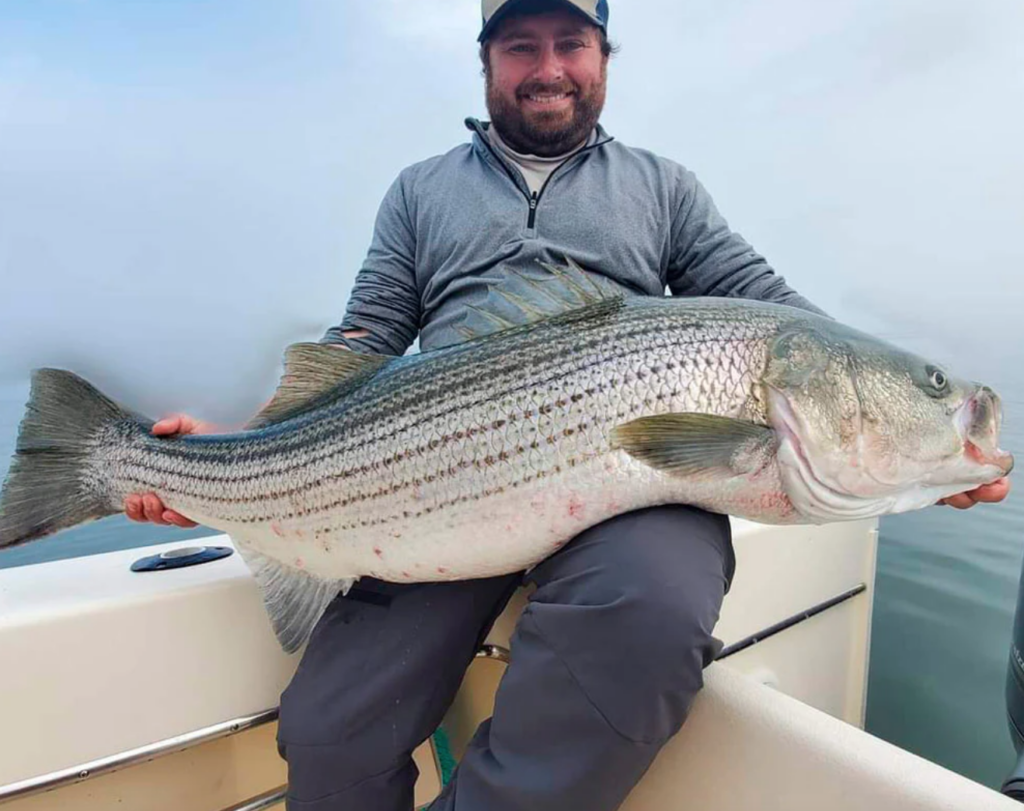
For most of the striped bass season, Capt. Taylor mixes live bait and artificial lures in Rhode Island, whereas Capt. Coombs switches to more live bait as the season wears on in Boston. Coombs and his clients use jumbo 9-inch walking topwater baits like Doc’s Drifters and beefy paddle tail swimbaits to imitate bunker or use live menhaden, porgies, or bunker, which are as large as the fish that many anglers target.
“We move toward live bait as it gets into August because the fish start to get lethargic in higher water temperatures,” said Coombs. “The bunkers we use weigh between a pound and 2 pounds. A 40-inch striped bass could swallow a 5-pound baitfish if it had to, and I’ve seen them eat ‘schoolie’ sized stripers.”
They rig the bunkers on 9/O TroKar circle hooks, bridle them for durability and a better hookup percentage, and either cast to targets or troll them. When rigging a trolling setup, they use the same hook and rig but add a 6-ounce trolling sinker and barrel swivel. For both, Coombs prefers braid to fluorocarbon.
“We use 40- or 50-pound Seaguar TactX—40-pound for casting distance with the live bait and 50-pound for trolling,” said Coombs. “When fishing around bunker and porgie schools, you want a beefier braid and leader material because those big schools of baitfish swimming around and hitting it can chafe your line. We like TactX because it’s a four-strand braid that holds up to the abuse.”
When fishing around hard structure, Capt. Coombs and his clients fly line the large baitfish with Shimano Thunnus 8,000-sized bait runner style reels and Shimano rods. “We pitch those baits out there and let them slap the surface. The striped bass hear the commotion and come investigate,” explained Coombs. “It’s slower fishing in shallow water. We target hard structure and get in real skinny water in the boulder fields.”
For his fluorocarbon leader materials, 40- and 50-pound Seaguar Inshore is Coombs’ go-to for abrasion resistance. Even when using a circle hook, he notices that about half of the fish get the bait down deep.
“Circle hooks don’t always get the fish right in the jaw. You need a good fluorocarbon leader for the abrasions from their mouths,” Coombs added. “When casting artificial baits, you can get away with 30-pound because they normally don’t get the bait as deep. We’re also proponents of a heavy drag, so we can put as much pressure on these fish to get them in as quickly as possible since we’re releasing them. That puts a lot of strain on the leaders, and they hold up very well for us.”
Using the right line becomes even more crucial as a toothy critter enters the system: the bluefish. Capt. Coombs will guide for them when they are around, but the striped bass often mix with them. Having the right line allows his clients to have a chance for both.
“August is when we start to get a big influx of bluefish. We get some really big ones, 10- to 20-pounders,” said Coombs. “Many anglers use wire leader, but I prefer an 80-pound Seaguar Inshore fluorocarbon leader. The line is abrasive enough that it won’t get chewed off by bluefish, but you still get bass in the mix. With a wire leader, those big striped bass won’t bite, showing how shy some can be, especially the older ones.”
RHODE ISLAND STRIPED BASS
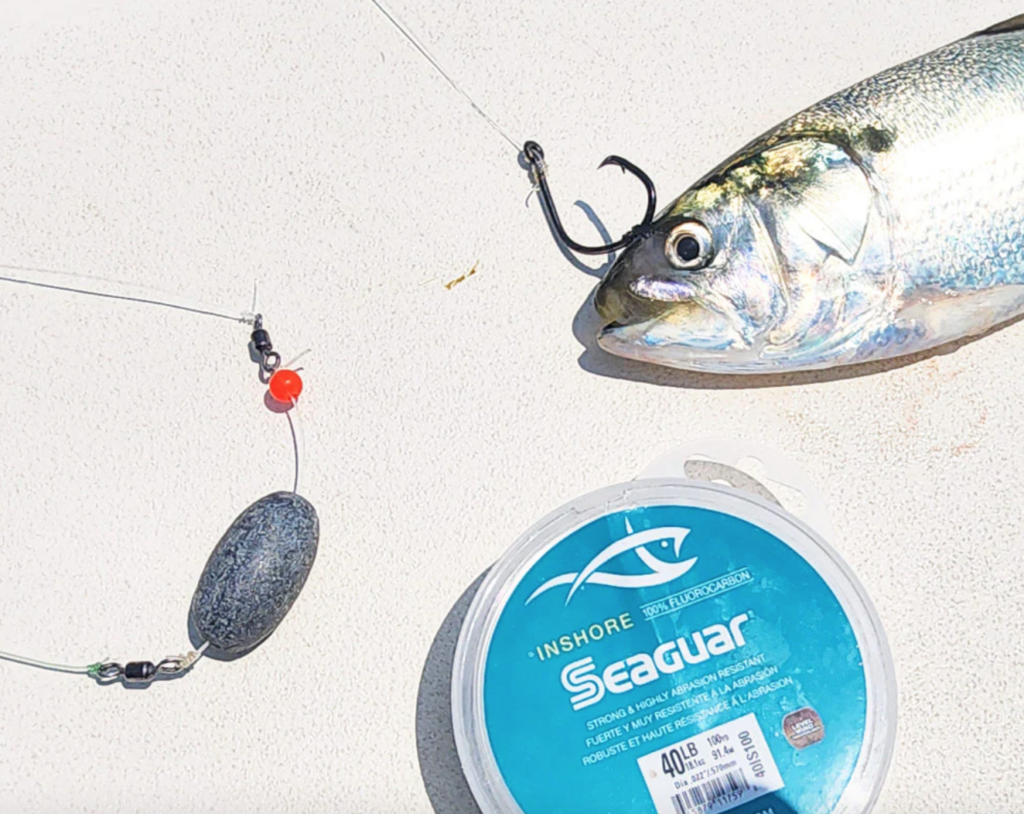
Captain Taylor says most of his striper action is offshore below Cape Cod. He will use live bait and artificial lures in tandem and says both bites can be excellent. He added that his fishery has plenty of bunker, menhaden, squid, and eels and that the striped bass are biting offshore and will be for the rest of summer.
“A lot of the focus is on deeper water around reefs and humps. It’s two-fold right now,” Taylor began. “We are fishing a lot of live eels and soft plastics. There has been a killer soft plastic bite on 8-inch paddle tails from No Live Bait Needed. We use varying weights of jigheads for the paddle tails and go on the lighter side from 3/4 to 2 ounces, which is light for offshore fishing.”
Using these lighter-than-normal jigheads has also opened Taylor’s eyes to the benefits of lighter lines. Even with massive striped bass swimming around him, his line of choice is 20-pound Seaguar TactX braid with a 40-pound Seaguar Fluoro Premier leader.
“Scaling down our braid has changed the game for us and allowed us to keep our baits in the strike zone longer in heavy current, both for the artificials and live bait,” said Taylor. “I used to use 50- and 65-pound braid. Now with the lighter braid and thinner diameter, you get a much better feel of your bait and what it’s doing and not a big lag, so the baits stay deeper. TactX ties knots very well and has proven to be highly abrasion-resistant. If a fish gets you in the rocks, you can move the boat over to them and still get those fish out.”
For the eels, which typically measure around 14-16 inches long, Taylor rigs a 7/O circle hook with a 1/2-ounce to 2-ounce weight on either a three-way rig or inline. His rod and reel of choice are a Jigging World Nexus 2.0 rod and a 50-sized Van Stall VSX2 reel. This combo allows him to use the same setup for both the swimbaits and live bait and he prefers the same line setup. His fluorocarbon leader is the only thing that changes. He chooses 40-pound Seaguar Fluoro Premier for most instances, unless he is fishing at night.
“If I’m fishing during the day, 40-pound is the way to go, and I always use longer leaders. I like at least 8 feet of fluorocarbon and connect it to the braid with an FG knot,” said Taylor. “Our waters offshore are super clean, and I’ve always trusted Fluoro Premier because of how thin, strong, and clear it is. You can beef it up to 80-pound test at night and put the boots to them because the fish are not as line-shy as in the daylight.”
The prized striped bass have proven to be a favorite species everywhere they swim, and there are countless ways to target them. The approaches of two noted Northeast captains are similar but different. Each has proven to be highly effective in their home waters.



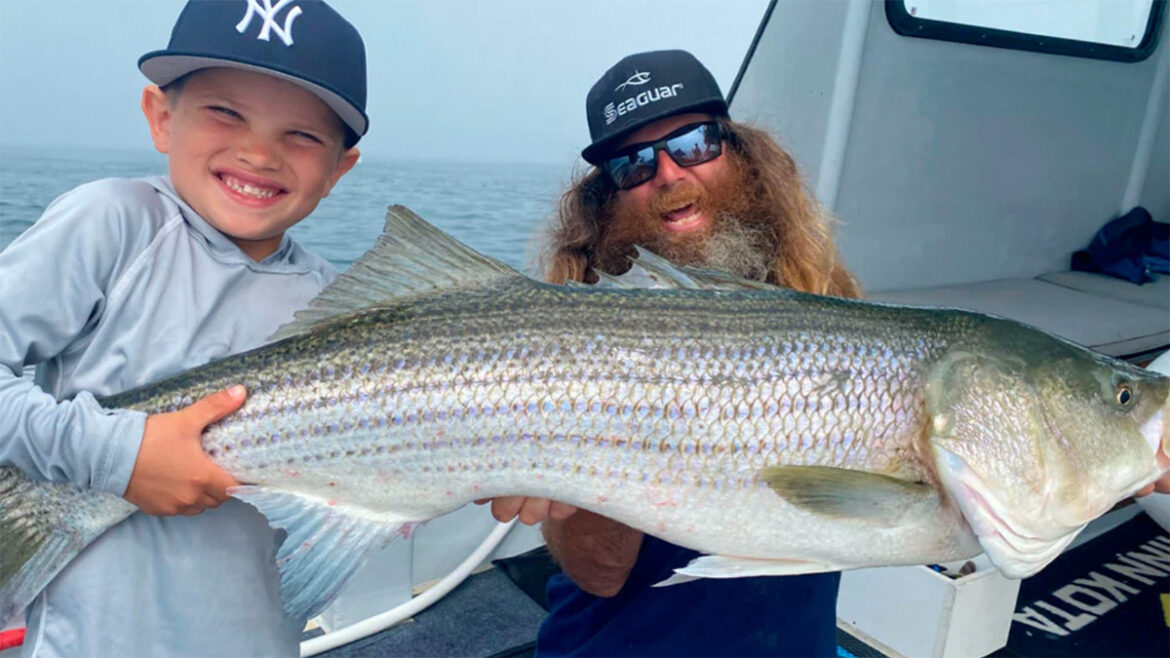
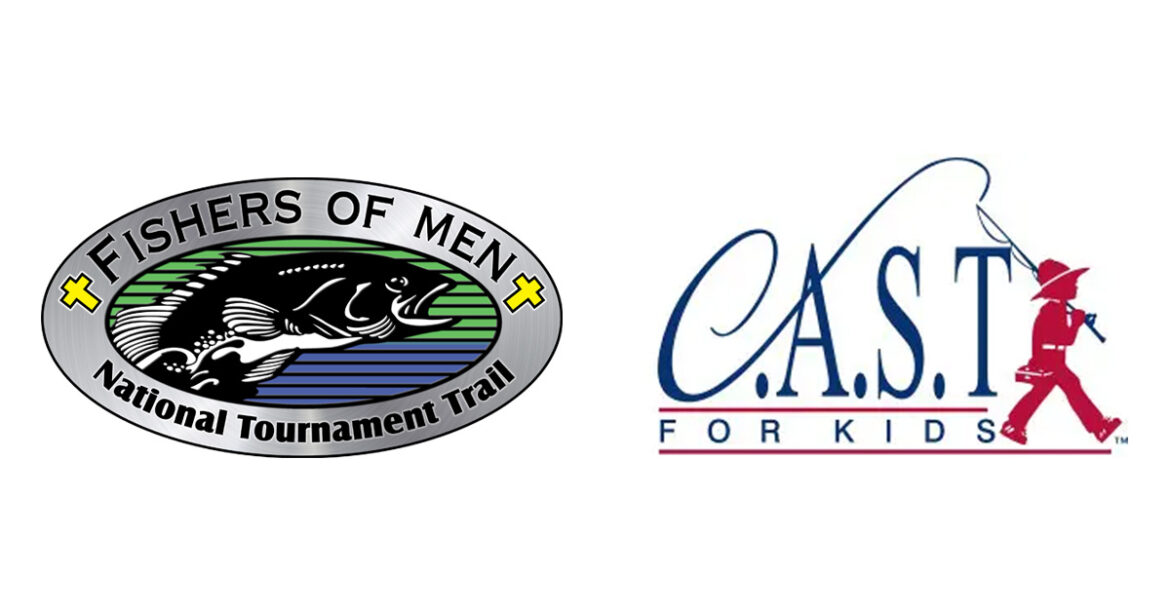
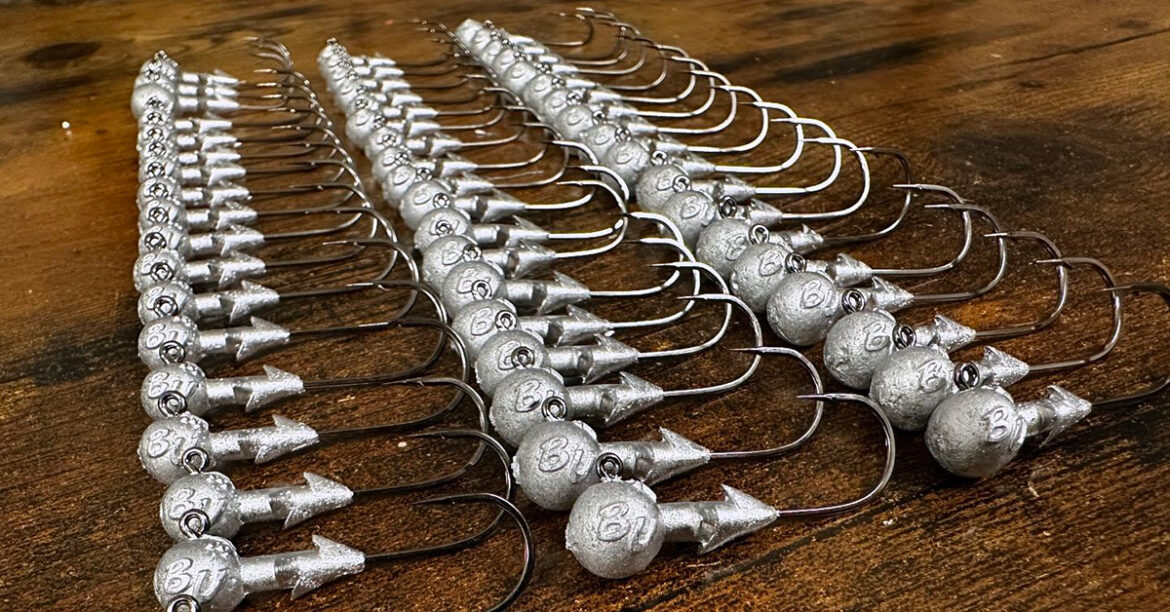
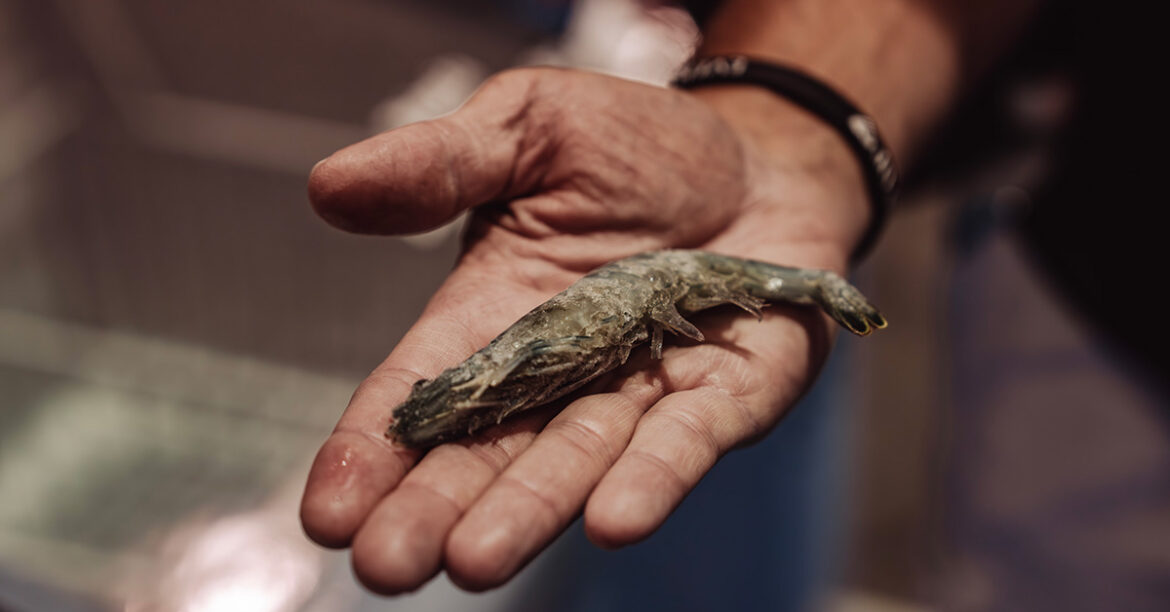
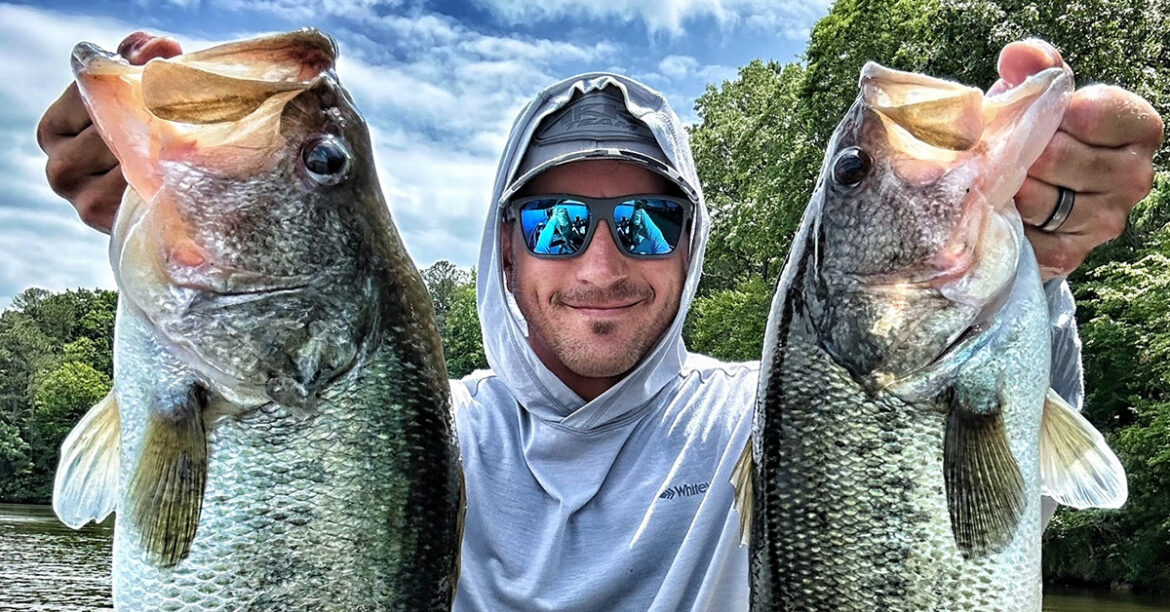
Leave a Reply